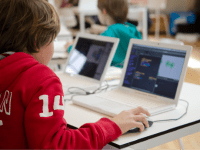The Power of Digital Story
Teachers can use their students’ world of digital media to nurture the listening, sharing, and persuasion that have long been part of oral and written storytelling.
Your content has been saved!
Go to My Saved Content.Telling our story is an essential part of our humanness. It allows us to feel part of the community that knows our story, and it fosters empathy for those that surround us. Story is a powerful force in shaping mental models, motivating and persuading others, and teaching the lessons of life. Telling story extends back to a time when oral history dominated the tools of communication. And now the flood of technology tools that allow for instant communication has spun us back into a golden age where story again dominates the media landscape.
Digital stories, now both easy to produce and simple to publish, are an ideal way to energize learning and engage students at a deeper level. Digital storytelling creates space for students to pursue topics about which they are passionate, grows their learning around assigned topics, and showcases their learning for peers, teachers, and audiences beyond the schoolhouse, all of whom are able to interact with the storyteller. To allow the power of story to blossom in learning spaces, it is necessary to focus on a few factors that can maximize its effect.
Create Space for Listening
The world is full of story -- just look at the fire-hose blast of Snapchat images, YouTube videos, and those moments of binge-watching Netflix. The noise of this digital information can be overwhelming. It can create a numbness to the outside world and limit the ability to retain and reflect on essential learning. Because of this, places of learning must be places of listening that allow time and space for the speed of life to be digested in a meaningful way. How have you practiced listening to story as a teacher, and how have you created this space for students? The power of digital story comes from the power of the audience that is genuinely engaged in listening to its message.
Persuade with the Head and the Heart
Digital story works because it fills our heads with engaging emotional rhetoric and paves a compelling reason to act or think differently. Emotion alone doesn't make digital story, as the names, faces, and numbers of the situation round out the message. Without the intellectual hook, the emotional plea can sound hollow and appear to be built on a flimsy foundation. The unique nature of digital story -- with its quick visual displays of information coupled with its engaging images of people, place, and planet -- provides the ideal media for amplifying the impact that comes from seamlessly weaving together these areas.
Lead with the Narrative
Great digital stories are rooted in their narrative. The beauty of digital story is that the narrative follows the same story arc that has always been a part of oral and written story. Helping kids become great presenters and great writers will support their proficiency as digital story creators.
Amplify with Images
A thousand words isn't the true power of images. Great images link story elements, humanize the abstract, and force the audience to see invisible people and places. Images are a gateway into the soul of stories. Digital story creators need to select each image with the same intentionality that each word is chosen for the narrative. Beautiful images allow digital stories to be remembered by more people in a deeper way.
Nurture the Process
Classrooms, schools, and districts that are rich in story will better support the learning of students who are already living in a culture of digital storytelling. Teachers, students, and community members need to feel an environment for learning that promotes voice, shares best practices, and celebrates the best of learning. In addition, the best of digital storytelling comes from the art of iteration. Success comes from publishing, revising, editing, analyzing, and tinkering with the craft. Allow time for adults and students to be a part of this powerful practice.
Understand the Tools
The quality and quantity of web-based tools for creating, designing, and making incredible digital story continues to grow. It is important for classrooms and schools to choose a few tools that work for them based on ease, accessibility, and cost, and take the time to really understand those tools both with and without content wrapped around their use. Currently, there are excellent stories being created using online tools like WeVideo and the editing tools within YouTube. Others are using iPhoto, Garageband, and iMovie to craft stunning digital stories that elicit strong emotion from audiences around the globe. In this process, students also have a chance to learn about the importance of using Creative Commons videos and properly crediting artists for their intellectual property. Some excellent student examples of these tools in action can be seen in Emma Bright's "My Defining Moment", MRH Middle School's "Dauphin Island Reflection", and Ollie J.'s "Eleven by Sandra Cisnaros".
Today's best tools for digital story will quickly become relics, so it is also essential to stay in the conversation, listen to what other educators are doing, and see what kids are using in their own creation space, so that the tools and features being used to create story will stay fresh.
Finally, it is essential to share story, personal and professional, successes and failures, because story inspires story. As we see through the beauty of digital story, idea generation, inspiration, and collaboration can only grow. And, in a larger sense, best practices in education will grow and scale whenever we all release trapped or siloed wisdom into the system.
How are you using the power of digital story in your classroom or school?
